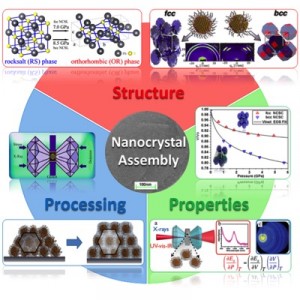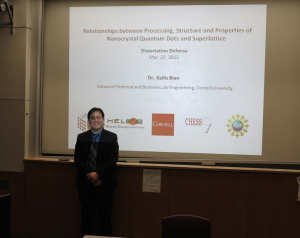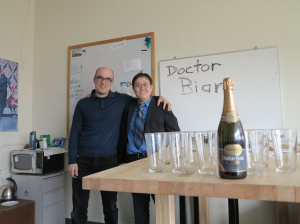Nanocrystal quantum dots are novel materials of great scientific and technologicalinterests. The attractive features of quantum dots include size-tunable optoelectronic properties, high optical absorption cross section and easiness of synthesis and deposition. These unique features qualify quantum dots as ideal materials for applications such as photovoltaic devices, sensors, light emitting diodes and bioimaging. In most circumstances, individual quantum dots cannot be utilized until they form macroscopic assemblies. Under proper conditions quantum dots self-assemble into periodical superlattices. The properties and performance of quantum dotassemblies depend on not only the intrinsic properties of isolated dots but also theirspatial arrangement or ordering. Consequently the relationships between processing,structure and properties of quantum dots and superlattices are of great importance inguiding the design and fabrication of novel nanomaterials with advantageous featuresusing quantum as building blocks. In this dissertation, I present my graduate researchstudying such trilateral relationships in lead chalcogenide quantum dot systems.
The first half of this dissertation discusses the relationship between processing andstructure of self-assembled superlattices. An overview of how the ligand-ligand interaction as the major driving force along with factors including particle size, shape, ligand morphology, solvents and interfaces determine superlattice morphology isprovided and followed by specific examples. (1) By tuning surface ligand morphology of PbS quantum dots and growth conditions, the effective particles shape was alteredand therefore different symmetries (fcc, bcc and bct) of superlattice were achieved. (2)The translational and orientational orderings in an fcc superlattice of cuboctahedronPbS quantum dots was decoded by small and wide angle x-ray scatterings. The dots showed two distinct orientations as a result of the interplay between particle shape andligand attractions. (3) Study of the nucleation, orientational alignment and symmetry transformations of PbS nanocubes at solvent-air and solvent-substrate interfaces is presented to demonstrate the role of interfaces as templates in guiding superlattice formation.
Presented in the second half of this dissertation are my research works using high pressure, which efficiently tunes both superlattice and atomic structures without altering chemistry, to probe the relationships between structure and properties of quantum dots systems. (1) Difference in the pressure-induced atomic phase transition pressure indicated that dots in bcc superlattice are more mechanically stable than thosein fcc due to translational and orientational orderings. (2) Elastic stiffness of PbS quantum dots were found to show size-dependence which is explained by a core-shell model. (3) Size-dependent variation of band gap of PbS quantum dot under elevated pressure was observed and correlated to changes of atomic structure. (4) Quantum dots were innovatively used as a nano-scaled tool to uniaxially compress organic moleculechains and measure the force-length relationship of single molecules.
The first half of this dissertation discusses the relationship between processing andstructure of self-assembled superlattices. An overview of how the ligand-ligand interaction as the major driving force along with factors including particle size, shape, ligand morphology, solvents and interfaces determine superlattice morphology isprovided and followed by specific examples. (1) By tuning surface ligand morphology of PbS quantum dots and growth conditions, the effective particles shape was alteredand therefore different symmetries (fcc, bcc and bct) of superlattice were achieved. (2)The translational and orientational orderings in an fcc superlattice of cuboctahedronPbS quantum dots was decoded by small and wide angle x-ray scatterings. The dots showed two distinct orientations as a result of the interplay between particle shape andligand attractions. (3) Study of the nucleation, orientational alignment and symmetry transformations of PbS nanocubes at solvent-air and solvent-substrate interfaces is presented to demonstrate the role of interfaces as templates in guiding superlattice formation.
Presented in the second half of this dissertation are my research works using high pressure, which efficiently tunes both superlattice and atomic structures without altering chemistry, to probe the relationships between structure and properties of quantum dots systems. (1) Difference in the pressure-induced atomic phase transition pressure indicated that dots in bcc superlattice are more mechanically stable than thosein fcc due to translational and orientational orderings. (2) Elastic stiffness of PbS quantum dots were found to show size-dependence which is explained by a core-shell model. (3) Size-dependent variation of band gap of PbS quantum dot under elevated pressure was observed and correlated to changes of atomic structure. (4) Quantum dots were innovatively used as a nano-scaled tool to uniaxially compress organic moleculechains and measure the force-length relationship of single molecules.





